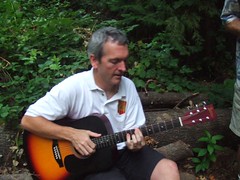What is it with our affliction with Power Point? Check out today’s Foxtrot:

FoxTrot by Bill Amend – September 8, 2006
Over the years, I have seen many cartoons, articles, and voices in education and the media taking pot shots at Power Point without ever really talking about the root of the problem: lacking a point for the presentation itself. Everyone from the Onion to Wikipedia takes shots at it. There is even the infamous Gettysburg Address made from a PPT template.
Rather than blaming the tool, why aren’t we talking more about how and why we compose with PowerPoint or other slide show programs? And, while Microsoft and other software makers would invite us to think that PowerPoint is just a tool…
“We are trying to make PowerPoint a much more intuitive product,” said John Duncan, product manager for Microsoft Office. “We are in the business of giving people easy-to-use tools. It is up to the users in terms of how they want to use them.”
Wired News: “The PowerPoint Amateur Hour”
… we also know that writers are bound by the affordances and constraints of what the software itself presents. But, it isn’t always about the tool.
Case in point: I was sitting through a session where a tech-savvy presenter wanted to share some information about a project, but said at the beginning how much he hated Power Point presentations. He then went on to his website, turned on a CSS template for a his presentation page, and created a bulleted list of points that he could scroll through screen by screen, just like a slide show. And then he talked. And talked. And talked. No bells and whistles. No audience interaction. Just a Power Point talk with the unofficial Power Point to go with it.
There are many harsh critiques of PPT, to be sure. For instance, check out the work of Edward Tufte. Some of this criticism is well-deserved, as Tufte points out here and here. And, the classic essay in for educators considering the use of PPT, McKenzie’s Scoring Power Points, is still worth a read. Given the new Michigan high school standards and expectations for students to create and publish digital media, I think that these three pieces should be required reading for teachers.
All that said, I am not quite so ready to dismiss PPT outright, although I want to be sure that we are using it in schools for more engaging purposes than what I imagine Paige has created for her book report. I recall the one time when a seventh grade student of mine made a really slick PPT – with different fonts, slide backgrounds, and animations (as her computer lab teacher taught her to do, sigh…) – about Roosevelt and his role in WWII. Unfortunately, she spent so much time on the PPT (and I, as a new teacher, forgot to scaffold her in the research process), that it was about one Teddy Roosevelt, not Franklin. Did PPT cause that problem? Partially, as the cut and paste ease of making the presentation was appealing. But part of it was just poor teaching and no self-monitoring by the student.
The other reason that this PPT issue caught my attention today is that earlier I talked to language arts consultants from around the state about doing digital storytelling workshops and, of course, the question of software came up. One person asked about PPT, in particular, because that was the only multimedia program that she knew how to use. Could that work for digital storytelling? While I think there are better programs for this, I said yes, PPT could work.
Honestly, if David Byrne can make PPT into art, then we can surely use it to make digital stories. But, remember, it is about the art, the story. Not the program. If they are pointless stories, then we will have the same reaction to PPT digital stories as Roger does to his co-workers and, perhaps, his daughter. Let’s keep the family happy and teach students like her how to make a point with multimedia, not just get lost in it.
Blogged with Flock
Like this:
Like Loading...


